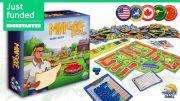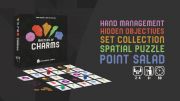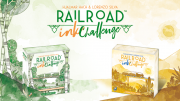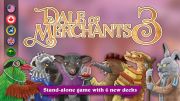Minigolf Designer (Thematic Games) – During your turn you pick a tile and add it to your minigolf course. Tiles are placed in a row in ascending order of value. When you take a tile, you move your pawn to the tile's space in the row. Pawn placement in the row will determine player turn order for the next selection, meaning that the more valuable a tile you choose this round, the more likely that you will be choosing last next round. When all players have completely filled in their course or choose to stop, the game ends. You earn one point for each person that appears across all your tiles. You also earn bonus points for specific features requested by client cards. Players additionally earn points for following certain layout restrictions. There is also an advanced rule variant in which players secretly bet on which placement restrictions they believe they will follow better than their opponents and earn bonus points if they are correct.
Casual Games on Kickstarter: Minigolf, Charms, and Bubble Tea

May brings deck builders, roll-and-writes, and tile laying to Kickstarter. There are also a couple of sequel games as the third in the Dale of Merchant series makes its debut, as well as a new Railroad Ink game. Throw in some bubble tea and adorable baking and you’ve got a fun assortment of casual games on offer.
Masters of Charms (Brickhouse Games) – You are collecting gemstones to make magical charms. On the table a grid of gemstone cards is placed. On your turn you play a portal card and place it under your meeple’s current location on the grid and then use it. The long lines on the portal card tell you how many cards you can move your meeple, and the short lines indicate how many times you can make an optional 90 degree turn. Once you land on a gem stone card, you may harvest it. When you have a set of three gemstone cards you can sell them. A portal card remains on the grid after you use it. When another meeple lands on it, it can be used again but is then discarded.
Curators (Worldshapers) – Each player is the curator of their own museum. You each have five different employees with their own unique abilities: finding objects for your museum, buying items for it, collecting money from visitors, expanding your museum with new tiles, and preparing objects you buy for display on your museum tiles. You have employee chips, with each side corresponding to one of your employees. On your turn, you use an employee's ability whose icon is currently showing on one of your chips and you flip it, revealing a different icon for a different employee on the other side. If two of your chips are currently showing the same icon, you can flip them both on your turn to take that employee's action twice.
Tapiru: A Bubble Tea Game (Elaine Shimokawa) – In this two player game, you are both competing to make the best cups of bubble tea. Each round you are building three cups. Each cup consists of three tapioca cards, one bottom card, one brand card, and one lid card. Tapioca cards show different numbers of tapioca on them. You start with a hand of two cards. On your turn you draw a card and then play a card to one of your three cups. There is a preference token placed between each of your cups and your opponent’s. These start the game flipped to the 'more' side. You can play a card on top of a card you previously played. If you place a bottom card on top of a previously placed bottom card, than the preference tile associated with that column of tea (which includes one of yours and one of your opponent’s) is flipped. Each card also shows a portion of a straw. Straws come in one of five possible colors. In order to earn a point bonus at the end of the round, all of a cup's straw pieces must match its branding card. When a player completes all three cups, his opponent gets one last turn and then the cups are scored. If at the end of the round you have over twenty pieces of tapioca across your three cups, you won't score any points this round. Based on whether each column's preference token is flipped to its 'more' or 'less' side, the player whose cup in that column beats his opponent in this requirement with amount of tapioca earns a scoring token.
Frenemy Pastry Party (Solis Game Studio) – Each player is dealt a secret animal card. Most animals want you to have the most of a specific type of ingredient in your score pile at the end of the game (while the otter just wants a set of all five). Then three recipe cards are placed on the table (these will be replenished as they are completed), and a row of five cards is placed in the center of the table face up (these are also replenished as they are drafted). On your turn you may either choose an ingredient card from the table to add to your hand or attempt to bake one of the recipes. Players are allowed to ask other players to donate ingredient cards to help them bake a recipe. You can ask multiple players and may ask for multiple ingredients, but only until you get two no's. If you still do not have enough ingredients to bake a recipe, then your turn is over. If you are able to bake the cake, it goes into your scoring pile along with your ingredients that you used. If a player donated ingredients, those ingredients go into their personal scoring pile. At the end of the game you score five points for each cake you baked and one point for each ingredient card in your score pile. You can also score your animal's bonus points if you met its requirements.
Railroad Ink Challenge (Horrible Guild) – In this roll-and-write game, each player takes a board and a marker. The goal of the game is to connect as many exits to each other as possible. Connecting multiple exits to each other is worth extra points. You also earn bonus points for drawing lines on the center spaces of your board and for having the longest railway or highway. Each turn the dice are rolled showing various icons which you then draw onto your board. There are also goal cards which give players certain configurations to work towards; however, you earn more points from them for being the first to complete these goals, so you want to beat your opponents to them.
Dale of Merchants 3 (Snowdale Design) – The third game in the Dale of Merchants series, Dale of Merchants 3 features six new animal decks which are sufficient to play a standalone game but can also be combined with the decks from the first two games. Players are setting up their merchant stalls in this deck-builder. Each card you purchase goes into your deck, but from there can also be added to your stall. Cards have unique abilities which grant you various special actions when played. Once a card is added to your stall, you can no longer use it for anything else, so you have to choose carefully which cards to add and when.
Disclosure: unless otherwise noted, we have not seen or played any of the above games. Our assessment of each is based on the information given on the crowdfunding project page.











